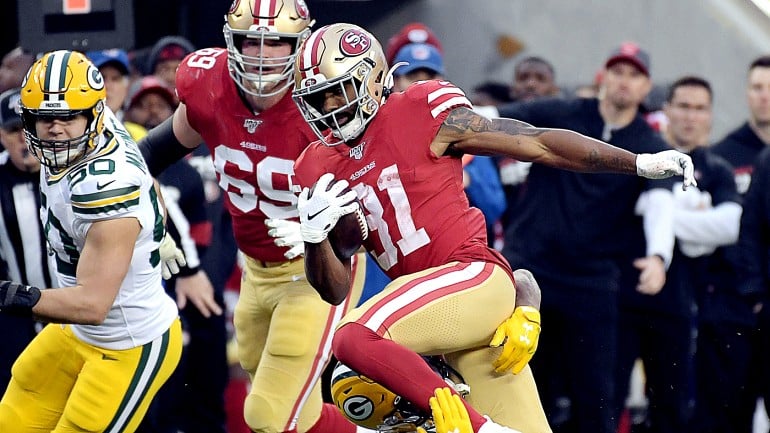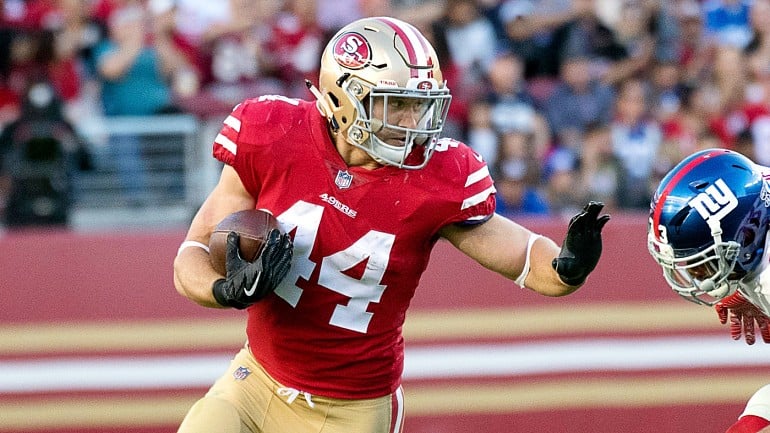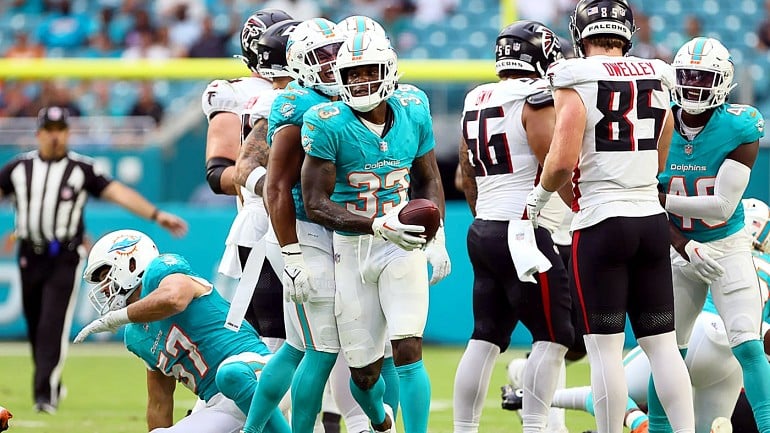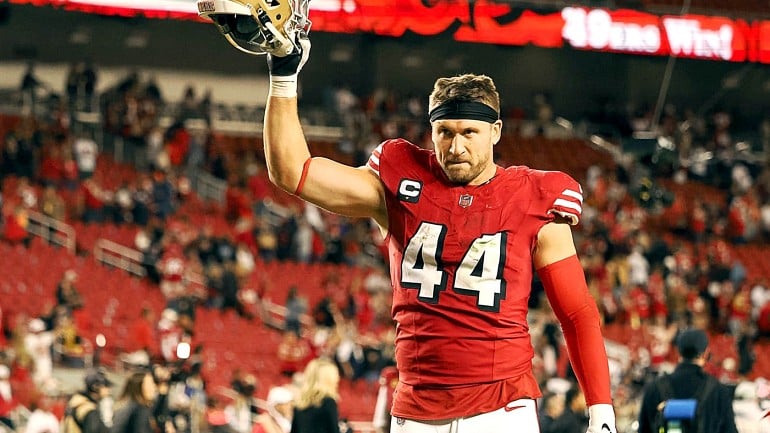The smashmouth running strategies of professional football might be a long memory. But football never strays too far from its roots.
Even twenty years into the 21st century, an NFL offense still relies upon a foundation of a swift running back weaving through a small gap between his linemen.
Don't forget what took the 2019 San Francisco 49ers to within minutes of a Super Bowl title: a high-powered run game and their stout defense.
Even with veteran Jerick McKinnon spending another year on injured reserve, the 49ers finished the regular season with 2,305 total rush yards, 23 touchdowns, and averaging 144.1 yards per game.
Veteran running back Raheem Mostert was a jack-of-all-trades for the team. He led the team in rush yards, touchdowns, and broken tackles on rushes with 12. He also played 199 special teams snaps, notching 11 tackles.
From Week 12 through Week 17, the 49ers' offense rushed 149 times for 815 yards and ten touchdowns. That's roughly 5.5 yards per rush average if you're keeping notes.
The threat of the run allowed Garoppolo to complete 111 passes for 1,500 yards and ten touchdowns. He was averaging 9.8 yards per attempt.
The 49ers' run game roared into the 2019 playoffs, stomping the Minnesota Vikings and Green Bay Packers with a steady diet of veteran running backs Tevin Coleman and Mostert.
Try not to get caught up in who the starting running back is for the 49ers; it's better to focus on the back's rotation – who's in during a particular series or for a specific set of downs and distance.
Raheem Mostert
Mostert's complete embarrassment of the Packers' run defense has gone down as one of the greatest football games I've seen live.
Consider Mostert's story before walking onto the field that January afternoon.
He'd played for four teams before landing with the 49ers late in 2016. Mostert showed up in Santa Clara with an NFL stat line that included one regular-season rushing attempt for six yards.
Mostert made it through general manager John Lynch's purge in 2017 and secured himself a roster spot due to his special teams play.
He found himself in the backfield more in 2018, and last year, Mostert led the 49ers in rushing with 772 yards and eight touchdowns.
Give credit to the five men upfront for what Mostert accomplished in the conference championship game. But also note what he can do when the running lanes are not the size of Mack trucks.
Week 14: 2nd Quarter – 1st and Goal at the NO 10 (:45)
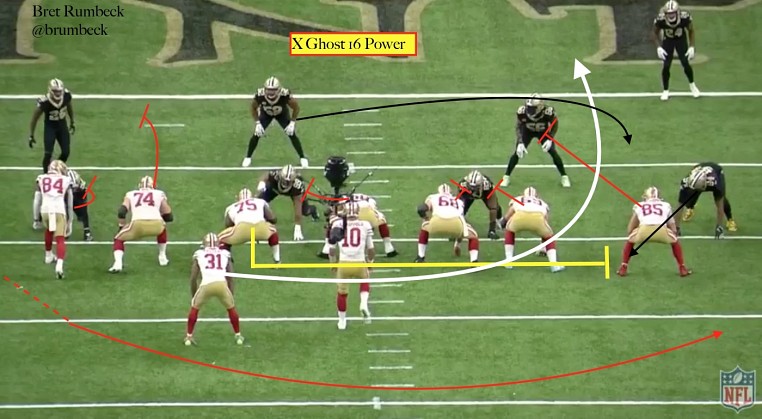
The Week 14 victory over the New Orleans Saints was an air assault, but Shanahan called a power run for Mostert in the middle of the game. In the middle of the air attack was a bread-and-butter power run that gave the 49ers the lead at the end of the first half.

The 49ers' offensive line created a chaotic mess near the 6-hole but left a clear path for left guard Laken Tomlinson to remove the defensive end.
Before the snap, Tomlinson made it clear he would pull right, lining up a foot back from the line of scrimmage. He didn't hit his block square, so Mostert had to cut quickly and weave his way through a narrow gap.
Shanahan's offense fits Mostert to the letter, allowing him to read his blocks, put his foot in the dirt, and turn upfield the moment he sees a way through the traffic.
Tevin Coleman
Last year, I thought the combination of former 49er running back Matt Breida, and Coleman was a deadly combination. To a degree, that is an accurate statement. Coleman finished third on the 49ers in rushing with 544 yards on 137 carries.
Coleman played in 14 regular-season games and made 11 starts at running back, and had a stellar divisional playoff game against Minnesota. It looked as if Coleman would have a similar day against Green Bay the next weekend, but an early injury sent him to the locker room.
Coleman can be a crucial cog in the 49ers' run game this year if he can stay healthy.
Divisional Round: 3rd Quarter – 3rd and 2 at the MIN 13 (5:39)
All-Pro defensive back Richard Sherman picked off Minnesota Vikings quarterback Kirk Cousins early in the third quarter. A 13-yard return put the 49ers at the Minnesota 29-yard line, but an unnecessary roughness call on rookie Nick Bosa backed the team up 15-yards.
Normally, I'd expect a head coach to call an intermediate or deep passing play to ensure the game's momentum stayed with his team.
Not Shanahan.
Instead, Shanahan called eight runs – three to Mostert and five to Coleman – and chewed up 4:55 minutes of clock, and resulted in seven points.
The 49ers broke the huddle and were in a 'Change Right' formation. 'Change' flips the backs, and 'right' tells the tight end where to align.
But tight end George Kittle motioned to the left side, putting the 49ers in a strong left formation.
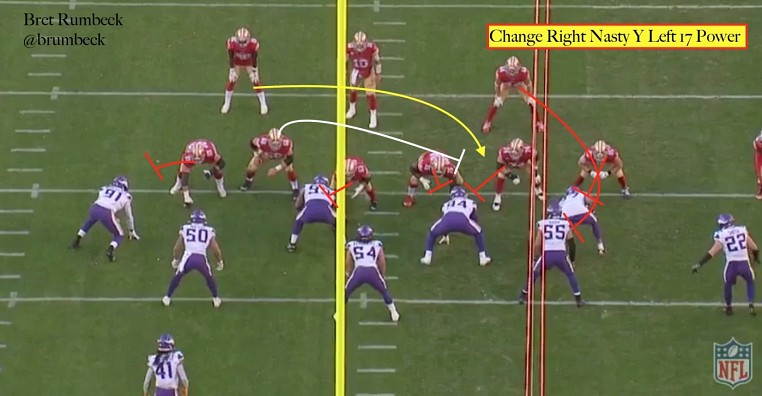
Shanahan's power runs keep the old school DNA, as he still attacks the strong side of the formation. But, as usual, Shanahan can run it out from a variety of looks.
With two backs, the fullback pinpoints the inside leg of the play side tackle and keys on the end man on the line of scrimmage. The pulling guard comes through and heads to the second level to shove aside any linebackers who might cause a problem.
The running back runs downhill toward the A-gap and read each gap from the inside out. Unlike a high school or junior college power that designates a specific hole for the running back, Shanahan allows the back to head through the two, four, or six holes.
Coleman found enough room to squeeze through and brought the ball to the Minnesota two-yard line.
Divisional Round: 3rd Quarter – 1st and Goal at the MIN 2 (4:57)
For all of Shanahan's genius, he often gets overlooked for how simple he keeps his game plan.
On the following play, he didn't make any substitutions, nor did he have the offense align in some exotic formation.
Like a bored high school coach looking to catch the starting defense sleeping, Shanahan flipped the previous play from the left side to the strong side.
The 49ers scored on '16 Power', using the same backfield, same motion, and pulling a guard to the right.
Jerrick McKinnon
There's no 49er I want to see more this season than McKinnon.
Before the first preseason game last year, McKinnon was removed from the physically-unable-to-perform list, adding another name to the 49ers' deep backfield.
But he would not see the field. McKinnon's surgically repaired knee was causing him problems, and then he underwent a platelet-rich plasma injection to try and his healing process.
McKinnon hasn't played a snap of meaningful football since January 21, 2018. I have no doubt the 49ers want to see what McKinnon can do in Shanahan's offense, mostly after Shanahan wanted him to be a vital part of the offense in 2018.
In a press conference on August 31, 2020, McKinnon noted that he was not nervous about playing in Week 1, but was 'more anxious.'
"I've been putting myself in the game situations and that game-type pressure on myself since day one, since we came out here, so I'm not nervous, or I don't have any butterflies or any of that type (of) stuff going into Week 1. It's just more anxious."
Getting McKinnon back up to game speed will take a few weeks. Expect Shanahan to work McKinnon slowly into the offense, giving him the ball on long down-and-distance plays or even something elementary like an outside zone run.
The success of the 49ers' offense will once again be on the shoulders of these three men, or possibly a fourth should the 49ers acquire running back Leonard Fournette.
All statistics courtesy of Pro Football Reference, unless noted.
All images courtesy of NFL.com.
